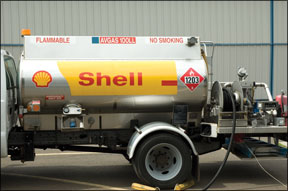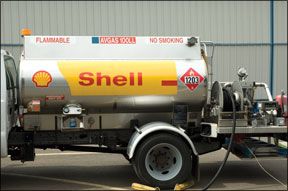Its no secret that 100LL aviation gasoline is one of, if not the, last leaded fuel in regular use in the U.S. Its also no secret-or at least it shouldnt be-that no other fuel offers the same capabilities throughout the general aviation piston fleet. Despite years of attempts to develop a substitute for tetraethyl lead (TEL, an additive helping boost fuel octane, preventing knock and valve-seat recession) or 100LL itself, nothing is FAA- 288 approved as a replacement. Yes, promising research is being conducted into a substitute fuel or additive-especially over the last year or so. As those paying attention to environmental issues associated with aviation fuels know, the lead content of 100LL has long been an issue. The element is responsible for several long-lasting health issues, including neurocognitive, neurobehavioral, sensory, and motor-function effects in children exhibiting relatively miniscule blood lead levels. Whats New? The U.S. Environmental Protection Agency (EPA) on April 28 published an advanced notice of proposed rulemaking (ANPRM) “on lead emissions from piston-engine aircraft using leaded aviation gasoline.” The ANPRM succeeds a petition filed in 2006 by Friends of the Earth requesting the EPA to find leaded avgas endangered public health. In 2007, the EPA responded to that petition by requesting comments and information from the public on a wide range of issues regarding the use of leaded avgas, including health and welfare detriments. According to the EPA, comments received as a result of the 2007 effort, “concerned the nature of the industry and fuel supply issues. The commenters did not supply information regarding health or exposure issues.” Some observers contend that statement from the ANPRM underscores a high level of dissatisfaction within the EPA regarding industrys inaction regarding 100LLs lead content. As one result, in 2008, the EPA initiated a lead study which will improve the ways EPA models emissions from piston-engine aircraft. Among the studys various actions is measuring the lead content of ambient air adjacent to general aviation airports. In its ANPRM, the EPA requests public comments on the data available for evaluating lead emissions, ambient concentrations and potential exposure to lead from the continued use of leaded avgas in piston-engine powered aircraft. The EPA notes a “positive endangerment and cause or contribute finding with respect to the emissions of lead from general aviation aircraft” would trigger the agencys duty to set emission standards. The EPA, it should be noted, is the federal agency establishing motor vehicle emission standards. Whats Next? Over the near term, very little likely will happen. In fact, as AOPA Vice President of Regulatory Affairs, Rob Hackman, told us, even presuming the EPA concludes avgas must become unleaded, “it will be a multi-year effort.” In this case, “multi-year” means, perhaps, five to 10 years, and possibly longer. Heres why. The ANPRMs comment period extends through June 28, after which the agency likely will spend substantial time evaluating its research and “to conduct a risk assessment evaluating the potential contribution of lead from piston-engine emissions on blood lead levels and IQ deficits for those living near or attending school near general aviation activity.” Among the airports at which the EPA expects lead monitoring to have begun by now are the Van Nuys (Calif.) Airport (VNY); the Phoenix (Ariz.) Deer Valley Airport (DVT); the Centennial Airport in Englewood, Colo. (APA); and the Daytona Beach (Fla.) International Airport (DAB). According to the EPA, “lead emitted by piston-engine aircraft operating on leaded avgas is the largest source of lead to the air, contributing about 50 percent” of airborne lead. Given such a relatively high contribution to airborne lead, and irrespective of whether the lead emitted by piston aircraft engines is significant, its nave to think the EPA will wont find 100LLs use constitutes “positive endangerment” to human health. Since, as one observer told us, 100LL is not the EPAs highest priority right now, its not likely such a determination would occur for a couple of years. Even though federal agencies can move quite quickly when they want to, the EPA probably would need a couple more years before developing a final proposed rule setting emission standards with the practical effect of banning 100LL by some future date. Such standards likely also would result in the FAA requiring newly certificated engines to have zero lead emissions, again by some future date. To comply with such a certification standard, the fuel burned in such engines must not contain lead. And therein is the problem: Safety and economic concerns largely preclude the likelihood of two aviation gasolines in the marketplace. Thus, the EPA/FAA will require lead-free avgas after a certain date. “Its a marathon, not a sprint,” AOPAs Hackman added. No one is willing to say when 100LL might be banned, but it looks like we have as many as 10 years to find alternatives. Industry Reaction While eliminating lead from 100LL is a worthwhile objective, how such a goal might be accomplished without grounding or establishing performance restrictions on scores of aircraft remains unknown. Likewise, the characteristics of any replacement for TEL or 100LL and how well it will work with the existing fleet of engine/airframe combinations is critical. Regardless, the two federal agencies involved must come up with a mutually agreeable solution. How well is that working out? “So far, the FAA and EPA are working together, as best I can tell, about as well as gasoline mixes with water.” So said one well-placed industry observer when asked about the ongoing relationship between the two agencies. Which goes back to our earlier point about the EPAs dissatisfaction with industrys (and the FAAs) response. That said, AOPAs Hackman remains optimistic: “EPA is really and truly becoming aware of the terrific hurdles associated with this issue and the industry is working to help. [The EPA] is not underestimating what it will take.” Whos right? Well find out soon enough, but never bet against the FAAs ability to annoy people. Alternatives Any alternative fuel failing to provide the same relative energy content/weight characteristics will force operational changes which may adversely impact safety. Too, an alternative fuels effects on specific engine/airframe combinations may not be fully understood until well after 100LL production ceases. Over the last few years, research into alternatives to 100LL has ramped up. Teledyne Continental Motors has come up with 94UL, basically 100LL without the lead. Swift Enterprises is developing its at-least-partially renewable Swift Fuel. General Aviation Modifications, Inc., is testing its G100UL. Whichever fuel reaches certification for new and existing engines first likely will be the winner in the ongoing race to develop a lead-free aviation gasoline. This is something all of us should be watching.




